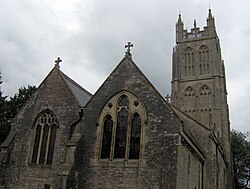|
Church of St Mary Magdalene, Chewton Mendip
The Church of St Mary Magdalene in Chewton Mendip, Somerset, England, was built in the 1540s and has been designated as a Grade I listed building.[1] It is dedicated to Jesus' companion Mary Magdalene. HistoryThe church has Saxon origins, with the register commencing in 560. Building work being undertaken in the 12th, 13th, 14th, 15th and 16th centuries with restoration in 1865.[1] The current church, which was started in 1441 by Carthusian monks,[2] incorporates several Norman features including the north doorway. The tower was added in 1541.[3] The church was a Saxon minster with subordinate chapels at Ston Easton, Emborough, Farrington Gurney and Paulton. The church was granted by William the Conqueror to the French Jumièges Abbey.[4] After the confiscation of alien churches Henry V gave it to the Priory of Sheen in Surrey which held it until the dissolution of the monasteries.[5] Wade and Wade in their 1929 book "Somerset" described the church as a "singularly interesting church, which possesses one of the most stately towers in the county".[6] Their description continued
The parish is part of the benefice of East Harptree with West Harptree and Hinton Blewett, Litton with Chewton Mendip within the archdeaconry of Wells.[7] Architecture The church is made of Lias Stone, with a 126-foot (38 m)[2] tower of Doulting Stone which was "unfinished" in 1541. The tower, which dates from around 1540,[8] contains a bell dating from 1753 and made by Thomas Bilbie of the Bilbie family.[9] In addition, there is a peal of eight bells by Taylor's of Loughborough. Near the altar, there is a stone seat for criminals taking sanctuary in the church. OrnamentsNear the altar is a stone seat, known as a 'frid' for those, especially criminals, who took sanctuary in the church.[2] The church includes monuments to Sir Henry Fitzroger and his wife who died in 1388, and to Frances, Lady Waldegrave (1879).[10] The Waldegrave family have owned Chewton from 1553, but did not live in the village until the 1860s.[11] The stained glass is largely from the 19th century, but some 15th-century and earlier fragments remain in the chancel window.[1] The glass in the north window of the chancel comes from various sources. The design of the virgin weeping was found in pieces in a ditch near Glastonbury. They were bought by the Rev. Paul Bush who used them to make a window in his summerhouse which was eventually pulled down. When the old vicarage was sold in 1956 the glass was found in the garden and shown to Christopher Woodforde the Dean of Wells. He identified some fragments as being 19th century but others as being much older possibly 13th or 14th century. Jasper Kettlewell combined them with existing glass in the window into new designs.[12] There are three piscinae, two medieval chests and 16th-century carved bench ends. The circular Early English font stands under the tower.[1] Churchyard crossA 15th-century stone cross in the churchyard also has Grade I listed building status.[13] See alsoReferences
|
||||||||||||||||
Portal di Ensiklopedia Dunia

